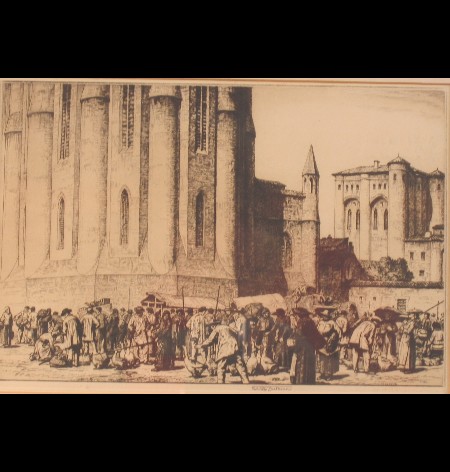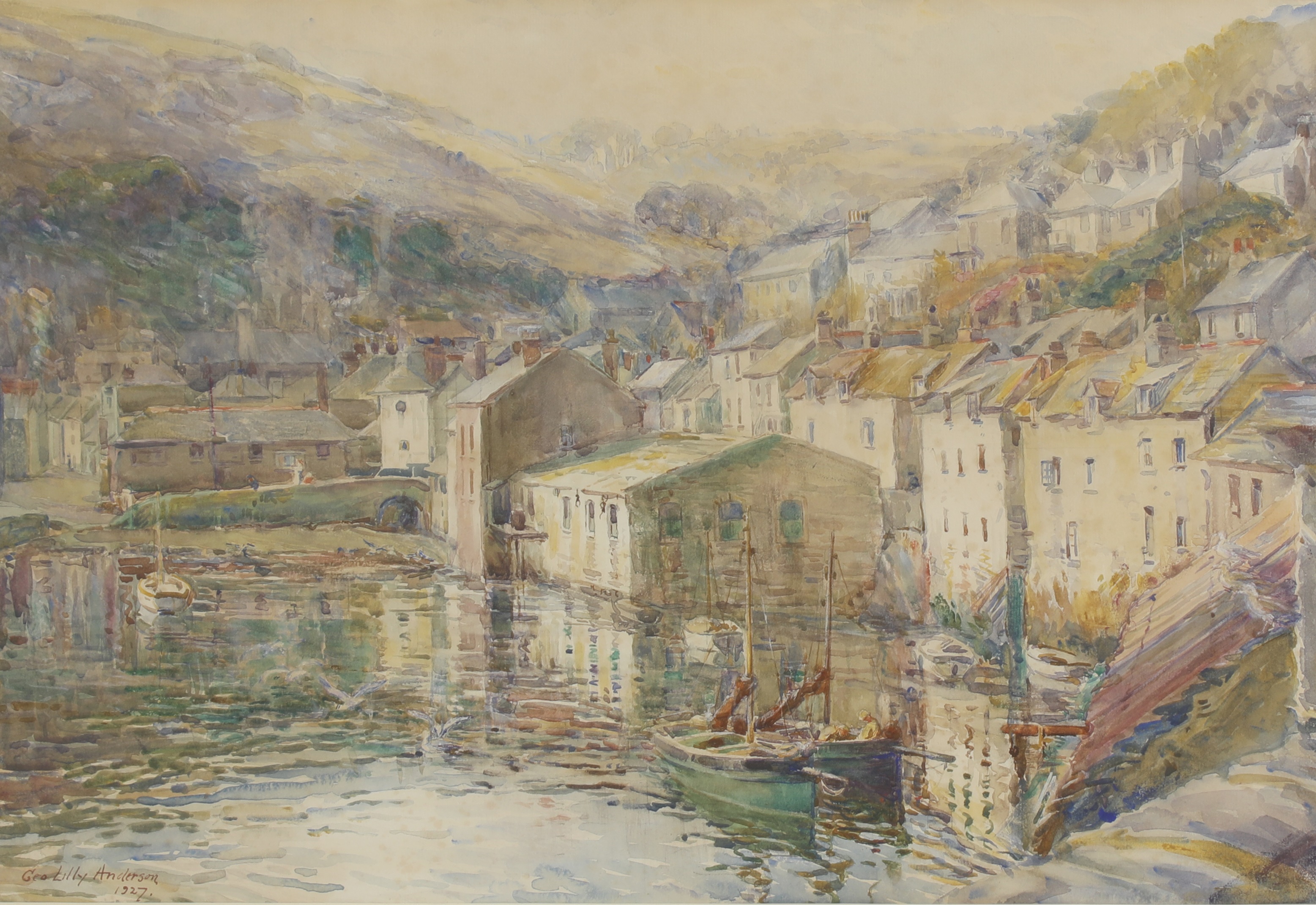J.W. Anderson (19th Century) The S.S. Great Eastern Laying Telegraphic Cables from Ireland to America Oil on canvas, 61 x 61cm (24 x 35.25'') Signed and dated 1868 (lr) The Great Eastern was a giant steam ship designed by Isambard Kingdom Brunel (1806-59). When she was launched at Millwall in 1858, she was the largest ship in the world. Although the design was groundbreaking, Brunel's mighty vessel was considered a commercial failure as a passenger liner. After being laid up in 1864 the Great Eastern was sold for ?25,000, a fraction of it's cost, to a Greenwich-based cable-laying company. The next stage of her career was by far the most successful. From 1865 to 1872 she laid four telegraph cables under the Atlantic, and others to link Bombay and Aden. The Telegraph Construction and Maintenance Company made the Atlantic cable at Greenwich in 1865. The Great Eastern was to lay the cable in one continuous length between Ireland and Newfoundland. The European end of the 1865 Atlantic cable was on top of the remote cliffs of Foilhummerum Bay, on Valentia Island, off the coast of Kerry. It was connected here to the existing landline. The American end was at Heart's Content in Newfoundland, Canada. Once the telegraph link had been established, Queen Victoria exchanged congratulations with President Andrew Johnson. The message took several hours to cross the ocean. Without the cable however, a dispatch going in one direction alone would have taken up to 12 days by inland telegraph and steamer. The public impact of the Atlantic telegraph was enormous. With landlines and submarine cables now connecting cities and trade centres, news and information could be passed almost instantly, where before it had taken weeks. J.W. Anderson (19th Century) The S.S. Great Eastern Laying Telegraphic Cables from Ireland to America Oil on canvas, 61 x 61cm (24 x 35.25'') Signed and dated 1868 (lr) The Great Eastern was a giant steam ship designed by Isambard Kingdom Brunel (1806-59). When she was launched at Millwall in 1858, she was the largest ship in the world. Although the design was groundbreaking, Brunel's mighty vessel was considered a commercial failure as a passenger liner. After being laid up in 1864 the Great Eastern was sold for ?25,000, a fraction of it's cost, to a Greenwich-based cable-laying company. The next stage of her career was by far the most successful. From 1865 to 1872 she laid four telegraph cables under the Atlantic, and others to link Bombay and Aden. The Telegraph Construction and Maintenance Company made the Atlantic cable at Greenwich in 1865. The Great Eastern was to lay the cable in one continuous length between Ireland and Newfoundland. The European end of the 1865 Atlantic cable was on top of the remote cliffs of Foilhummerum Bay, on Valentia Island, off the coast of Kerry. It was connected here to the existing landline. The American end was at Heart's Content in Newfoundland, Canada. Once the telegraph link had been established, Queen Victoria exchanged congratulations with President Andrew Johnson. The message took several hours to cross the ocean. Without the cable however, a dispatch going in one direction alone would have taken up to 12 days by inland telegraph and steamer. The public impact of the Atlantic telegraph was enormous. With landlines and submarine cables now connecting cities and trade centres, news and information could be passed almost instantly, where before it had taken weeks.
J.W. Anderson (19th Century) The S.S. Great Eastern Laying Telegraphic Cables from Ireland to America Oil on canvas, 61 x 61cm (24 x 35.25'') Signed and dated 1868 (lr) The Great Eastern was a giant steam ship designed by Isambard Kingdom Brunel (1806-59). When she was launched at Millwall in 1858, she was the largest ship in the world. Although the design was groundbreaking, Brunel's mighty vessel was considered a commercial failure as a passenger liner. After being laid up in 1864 the Great Eastern was sold for ?25,000, a fraction of it's cost, to a Greenwich-based cable-laying company. The next stage of her career was by far the most successful. From 1865 to 1872 she laid four telegraph cables under the Atlantic, and others to link Bombay and Aden. The Telegraph Construction and Maintenance Company made the Atlantic cable at Greenwich in 1865. The Great Eastern was to lay the cable in one continuous length between Ireland and Newfoundland. The European end of the 1865 Atlantic cable was on top of the remote cliffs of Foilhummerum Bay, on Valentia Island, off the coast of Kerry. It was connected here to the existing landline. The American end was at Heart's Content in Newfoundland, Canada. Once the telegraph link had been established, Queen Victoria exchanged congratulations with President Andrew Johnson. The message took several hours to cross the ocean. Without the cable however, a dispatch going in one direction alone would have taken up to 12 days by inland telegraph and steamer. The public impact of the Atlantic telegraph was enormous. With landlines and submarine cables now connecting cities and trade centres, news and information could be passed almost instantly, where before it had taken weeks. J.W. Anderson (19th Century) The S.S. Great Eastern Laying Telegraphic Cables from Ireland to America Oil on canvas, 61 x 61cm (24 x 35.25'') Signed and dated 1868 (lr) The Great Eastern was a giant steam ship designed by Isambard Kingdom Brunel (1806-59). When she was launched at Millwall in 1858, she was the largest ship in the world. Although the design was groundbreaking, Brunel's mighty vessel was considered a commercial failure as a passenger liner. After being laid up in 1864 the Great Eastern was sold for ?25,000, a fraction of it's cost, to a Greenwich-based cable-laying company. The next stage of her career was by far the most successful. From 1865 to 1872 she laid four telegraph cables under the Atlantic, and others to link Bombay and Aden. The Telegraph Construction and Maintenance Company made the Atlantic cable at Greenwich in 1865. The Great Eastern was to lay the cable in one continuous length between Ireland and Newfoundland. The European end of the 1865 Atlantic cable was on top of the remote cliffs of Foilhummerum Bay, on Valentia Island, off the coast of Kerry. It was connected here to the existing landline. The American end was at Heart's Content in Newfoundland, Canada. Once the telegraph link had been established, Queen Victoria exchanged congratulations with President Andrew Johnson. The message took several hours to cross the ocean. Without the cable however, a dispatch going in one direction alone would have taken up to 12 days by inland telegraph and steamer. The public impact of the Atlantic telegraph was enormous. With landlines and submarine cables now connecting cities and trade centres, news and information could be passed almost instantly, where before it had taken weeks.















Testen Sie LotSearch und seine Premium-Features 7 Tage - ohne Kosten!
Lassen Sie sich automatisch über neue Objekte in kommenden Auktionen benachrichtigen.
Suchauftrag anlegen